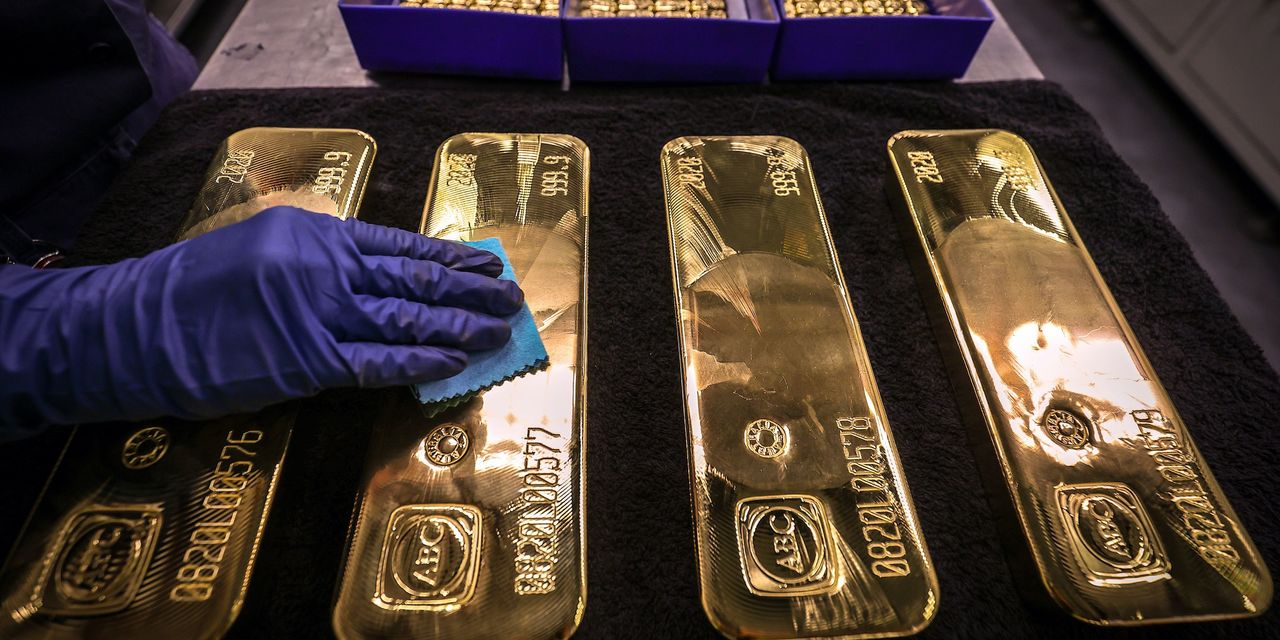Investors tried and failed earlier this month to lift gold prices to a fresh record high and even the risk of a U.S. debt default has been unable to keep prices for the precious metal above the key $2,000 level.
Gold, however, still has a good chance to reach an all-time high before the year is done.
The market uncertainty brought about by the wrangling in Congress over raising the U.S. debt ceiling, mentions of a potential technical default as soon as June 1, and even a warning of a potential U.S. credit rating downgrade by Fitch, “while clearly gold positive, failed to become a true catalyst for gold prices from these levels,” said Imaru Casanova, portfolio manager, gold and precious metals, at VanEck. “The market expects a deal to be reached” on the debt ceiling.
Read: Here are 3 key things to know about markets and the debt-ceiling fight as Memorial Day weekend approaches
Gold futures
GC00,
GCM23,
GCQ23,
made a run toward fresh record highs in early May, settling as high as $2,055.70 an ounce on May 4, the second highest on record and highest for a most-active contract since Aug. 6, 2020 when when prices finished at a record high of $2,069.40, according to Dow Jones Market Data.
Prices have settled below the key $2,000 mark for the nine consecutive sessions as of Friday.
The precious metal has actually been “flirting” with the $2,000 level for over a decade now, said George Milling-Stanley, chief gold strategist at State Street Global Advisors.
It started in 2011, “the last time political wrangling over the debt ceiling was a significant issue,” with prices coming close to $2,000 in September of that year, he told MarketWatch. Gold surpassed that key level in 2020 and again earlier this year.
Read Gold at $2,000: Why it took so long for the precious metal to solidly breach that key level
Given that gold prices have been flirting with a new high above $2,000 for more than a decade, the belief that any price above that key level was the right level to take profits “became firmly entrenched in the minds of investors and speculators,” said Milling-Stanley, offering a long-term reason why gold has so far failed to reach a new record high. Short term, gold hasn’t successfully reached a fresh high because the markets “suddenly came to the conclusion that there would be a favorable outcome to the debt-ceiling debate and the U.S. would not default on its debt.”
Even so, Milling-Stanley believes the “economic and political situation, coupled with some favorable developments in gold demand seem likely to propel prices back above that level” this year.
Read: Why gold prices hitting a record-high may be ‘inevitable’ as investors seek havens for shelter
‘Market complacency’
An actual U.S. debt default would be “disastrous and should push gold much higher,” VanEck’s Casanova told MarketWatch.
However, “market complacency” has set in, she said. Even after another bank failure — First Republic Bank’s seizure by the U.S. government and sale to JPMorgan Chase — the markets “assume the banking turmoil is over and ignore the risks that remain by the significant stress imposed on the economy by sustained higher interest rates, and persistent inflation above the Federal’s Reserve’s target,” Casanova said. Data released Friday revealed a 0.4% rise in the cost of U.S. goods and services in April.
With inflation significantly above the Fed’s target, the central bank is “stuck between a rock and a hard place,” Casanova said. “The fight against inflation is clearly not over, but [the Fed] may be forced to stop its rate hiking program before another crisis develops somewhere else.”
She said gold may currently be in a “privilege position.” A Fed pause in its rate hiking campaign raises a flag — that the economy is so weak that the central bank is afraid of causing too much damage by increasing rates further, she said.
“This is gold positive both because a weak economy sends investors running to gold, and because lower rates make gold more attractive to own,” Casanova explained. “The longer-term implications of a Fed pause on inflation expectations could also support gold,” given questions over whether inflation will remain elevated, she said, as gold is considered a hedge against inflation.
On Friday, the most-active June gold futures contract settled at $1,944.30 an ounce on Comex, down for the week as well as the month, but still 6.5% higher year to date.
Gold may still rally back above $2,000 and move on to set new all-time highs, with a failure to reach a satisfactory resolution to the debt ceiling issue among the potential catalysts for a move higher, said Milling-Stanley.
A recession would also be a potential catalyst, he said, pointing out that there have been seven significant recessions over the past 50 years, and the annual average appreciation in the gold price during those seven recessions was over 20%.
This year, it’s likely gold prices will climb back over $2,000 and it’s “quite possible that gold will set a fresh all-time high,” Milling-Stanley said.
Read the full article here


